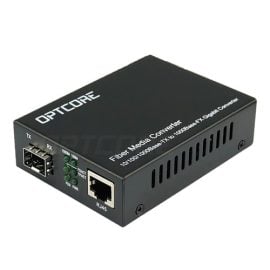Blog, Network Cabling
PoE vs PoE+ vs PoE++ vs UPoE vs UPoE+: What is the difference?
In the telecom field, you often hear about PoE, PoE+, PoE++, UPoE, and UPoE+. You might even be using some PoE devices. But what’s the difference between PoE and PoE+? And how does PoE+ vs PoE++?
This post will dive into this topic and provide a comprehensive guide and comparison. Let’s get started.
Table of contents
What is PoE?
Power over Ethernet (PoE) is a technology that transmits DC power and data to devices over a network cable. PTZ cameras, VoIP phones, wireless access points, and other devices will not need separate power supplies and outlets. All you need is a network cable.
PoE technology makes network connection simpler and more cost-effective.
PoE Switch
PoE technology has been widely used in switches, media converters, and other devices. A PoE switch is a practical application of this technology. It is a kind of PSE (power sourcing equipment) that can power devices(PD) through an Ethernet cable to make a network connection.
In a PoE system, the device that provides power is called a power supply equipment (PSE), and the device that uses the power is called a powered device (PD).
Examples of PSE equipment include PoE switches, injectors, and media converters.
PD equipment examples include APs, IP cameras, and other devices.
Please remember the shore words PSE and PD. We will mention them again and again following.

Figure 1: PoE Switch
PoE vs PoE+, What is the difference?
1. PoE Standard
The Power over Ethernet technology standard, also known as PoE Type 1, was born in 2003 under the IEEE 802.3af standard.
Since PoE technology was initially used to power IP phones and remote cameras, the power required is not very high. Therefore, in the 802.3af specification, two pairs of Cat3 cables transmit power and data. The PSE device supports a maximum power consumption of up to 15.4W per PoE port.
At first, this standard allowed Powered Devices (PDs), such as PTZ cameras, to receive up to 12.95W of power using only two of the four twisted pairs in Ethernet cabling.
2. PoE+ Standard
As devices began to require more power, PoE+ technology was created in 2009, and a new standard, IEEE 802.3at, was created. It is also called PoE type 2.
The PoE+ switch also supplies power over two pairs of network cables, but this new standard allows one PSE port to Provide a maximum of 30W power to PD, which can reach 25.5W.
The ratification of IEEE 802.3at has brought significant changes to PoE. These include the designation of Category 5e cables as the minimum cable rating required to support the new PoE+ standard.
The PoE+ switch’s increased power supply capability is suitable for devices that require more power, such as high-power wireless APs, multiple devices for video surveillance systems, VoIP phones, and industrial automation equipment. These devices have higher power stability and signal transmission quality requirements, and PoE+ PSE provides a solution to meet these needs.
3. PoE vs PoE+
After the emergence of PoE technology, it began to evolve, and related standards started to appear. However, one of the most critical indicators in its development is the maximum power of PSE and PD.
PoE switches can use Cat3 cables to transmit power, but PoE+ Switches need to use Cat5 or better cables. Of course, we suggest you choose Cat5 cable or better for PoE and PoE+ Switches now. CAT5 network cables also have lower impedance than CAT3. After all, the Cat3 cable is out of date, and the important thing is that the Cat5 cable is more popular now.
PoE and PoE+ switch both supply power over two of the four twisted pairs of the network cable to the PD device, but the later PoE+ PSE power is twice that of PoE, and it can power more powerful end devices, such as VoIP phones and WLAN access points.
In addition, PoE+ allows network administrators to offer greater functionality, such as providing new remote power diagnostics, status reports, and power management for powered devices. PoE+ is an upgraded PoE version compatible with the IEEE 802.3af standard.
More differences between PoE and PoE+. Please reference the below sheet.
| Type | PoE(Type-1) | PoE+(Type-2) |
| Standard | IEEE 802.3af | IEEE 802.3at |
| Standard Ratified | 2003 | 2009 |
| Power available at PD | 12.95 W | 25.5 W |
| Max. Power from per POE Port | 15.4 W | 30 W |
| Voltage range (at PSE) | 44.0–57.0 V | 50.0–57.0 V |
| Voltage range (at PD) | 37.0–57.0 V | 42.5–57.0 V |
| Recommended Cable type | Cat3 or Better | Cat5e or Better |
| Energized Pairs | 2-pair | 2-pair |
| Suggested distance | <100m | <100m |
| Maximum current Imax | 0.35 A | 0.6 A |
| Supported Devices | Static or PTZ cameras, VoIP phones, wireless access points(VoIP Phones Access Points Sensors Static CCTV Cameras) | PTZ cameras, video IP phones, alarm systems(Video IP Phones Alarm Systems Pan/Tilt/Zoom Cameras) |
What is PoE++?
As devices continued to evolve and upgrade, so did power consumption, and naturally, PoE technology and standards were quickly upgraded again.
In 2018, the IEEE 802.3 standard was upgraded again to PoE++ IEEE 802.3bt standard. With this, the Ethernet infrastructure has raised the energy available to power devices to a new standard. The IEEE 802.3bt standard includes Type-3 and Type-4. In Type-3, the per port of PSE can provide a maximum of 60W to PD via four twisted network cable pairs, and the MAX PD Power can reach 51W. In Type-4, the per port of PSE can provide a maximum of 100W.
In the PoE++ IEEE 802.3bt standard, both of these PoE++ PSEs use 4 pairs of twisted-pair cables to transmit power and cable, so they are sometimes also called 4PPoE(4 Pair Transmission PoE).

Figure3: PoE+ VS PoE++ using Network cable
Cisco’s proprietary technology UPoE
The development of Power over Ethernet (PoE) technology is closely associated with CISCO.
Before introducing PoE++ technology, Cisco devised an innovative method to deliver up to 60 watts of power over standard Category 5e or higher cables using Cisco UPoE® (Universal Power over Ethernet).
A Cisco UPoE switch can provide up to 60W on each PoE port as PoE++ type 3 switches. Because Cisco’s UPOE is similar to the PoE+ Type3, Sometimes UPOE is called PoE++.
This technology can provide reliable network power to many devices, including virtual desktop terminals, IP turrets, compact switches, building management gateways, LED lights, wireless access points, and IP phones.
What is UPoE+?
UPoE+ is an upgrade to Cisco’s UPoE technology, increasing the PoE switch per port to 90 watts. The Max PD Power can be 71.3W.
Cisco UPoE+ integrates the latest IEEE 802.3bt standard with Cisco UPoE, enabling UPoE+ switches to be fully compliant with the 802.3bt standard. Furthermore, they are compatible with all previous standards, such as 802.3af and 802.3at, in addition to Cisco UPoE.
It’s worth noting that UPoE and UPoE+ are specific to Cisco and may not work with non-Cisco devices. The same applies to similar technologies from other providers.
PoE vs PoE+ vs PoE++ vs UPoE vs UPoE+
The following comparison chart provides a detailed analysis based on the introduction above. It will help to clarify the specifications for better understanding.
| Type | PoE(Type-1) | PoE+(Type-2) | PoE++(Type 3) | PoE++(Type 4) | UPoE | UPoE+ |
| Standard | IEEE 802.3af | IEEE 802.3at | IEEE 802.3bt | IEEE 802.3bt | Cisco | Cisco |
| Standard Ratified | 2003 | 2009 | 2018 | 2018 | 2014 | 2018 |
| Power available at PD | 12.95 W | 25.5 W | 51 W | 71.3 W | 51 W | 71.3W |
| Max. Power per PoE Port | 15.4 W | 30 W | 60 W | 100 W | 60 W | 90 W |
| Voltage range (at PSE) | 44.0–57.0 V | 50.0–57.0 V | 50.0–57.0 V | 52.0–57.0 V | 50.0–57.0 V | 52.0–57.0 V |
| Voltage range (at PD) | 37.0–57.0 V | 42.5–57.0 V | 42.5–57.0 V | 41.1–57.0 V | 42.5–57.0 V | 41.1–57.0 V |
| Recommended Cable type | Cat5e or Better | Cat5e or Better | Cat5e or Better | Cat6a or Better | Cat5e or Better | Cat6a or Better |
| Energized Pairs | 2-pair | 2-pair | 4-pair | 4-pair | 4-pair | 4-pair |
| Suggested distance | <100m | <100m | <100m | <100m | <100m | <100m |
| Maximum current Imax | 0.35 A | 0.6 A | 0.6 A | 0.96 A | 0.6 A | 0.96 A |
| Supported Devices | Static or PTZ cameras, VoIP phones, wireless access points(VoIP Phones Access Points Sensors Static CCTV Cameras) | PTZ cameras, video IP phones, alarm systems(Video IP Phones Alarm Systems Pan/Tilt/Zoom Cameras) | Video conferencing equipment, multi-radio wireless access points(Laptop’s TV’s LCD Monitors) | PoE-Powered LED Lighting, outdoor PTZ cameras | Cisco and compatible devices | Cisco and compatible devices |
With the development of network interruption, PoE technology standards should constantly be updated for new technologies. Let’s look for!
If you need a PoE device, such as a PoE and PoE+ media converter, please go ahead and have a look at the products below!
-
 10/100/1000Base-T RJ45 to 1000Base-LX SC 1310nm 10km Fiber PoE+ Media ConverterUS$ 31.00 (Excl. VAT)
10/100/1000Base-T RJ45 to 1000Base-LX SC 1310nm 10km Fiber PoE+ Media ConverterUS$ 31.00 (Excl. VAT) -
 10/100/1000Base-T RJ45 to 1000Base-FX SFP Fiber PoE Media ConverterUS$ 19.90 (Excl. VAT)
10/100/1000Base-T RJ45 to 1000Base-FX SFP Fiber PoE Media ConverterUS$ 19.90 (Excl. VAT)
Reference:
- https://www.cisco.com/c/en/us/solutions/collateral/enterprise-networks/nb-06-upoe-plus-it-ot-wp-cte-en.html
- https://en.wikipedia.org/wiki/Power_over_Ethernet







